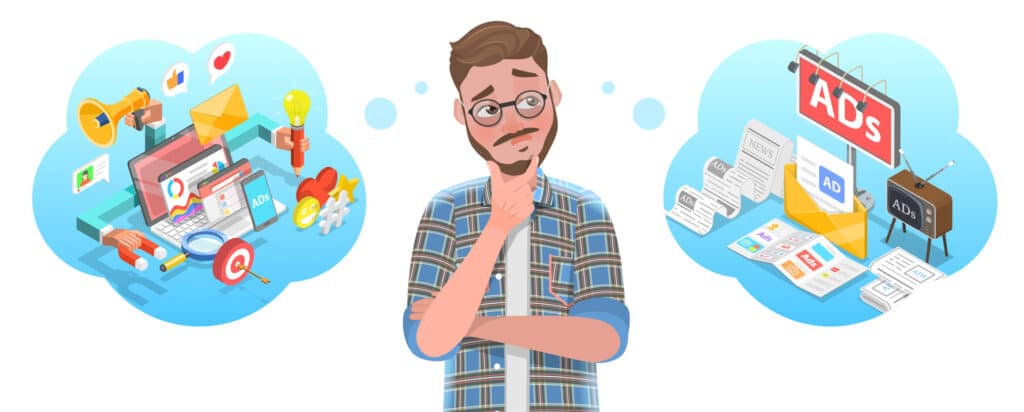It can be easy to get marketing and advertising mixed up, or to think they are the same thing. However, there are key differences! Today we will take a look at the differences between the two and help you better understand what each area individually entails.
Let’s start by looking at how each term is defined:
Marketing: the activities a company undertakes to promote the buying or selling of a product or service
Advertising: The activity of making products or services known about and persuading people to buy them
As you can see, there’s some overlap there – so let’s break it down a bit more clearly:
Marketing
Marketing involves the process of identifying customer needs and determining how to meet those needs. When crafting your marketing strategy, you should account for the 7 P’s of marketing. The 7 P’s are:
Product: The thing you are offering in exchange for money.
Pricing: The amount of money you are asking for in exchange for the product.
Place: Where your target audience goes to find information about your product. (Target audience is a group of people with interests and demographics that align with your brand).
Promotion: How customers find more about you. This is often done with advertising, which is properly understood as a component of marketing.
People: This refers to anyone who comes in contact with your customer, including indirectly, e.g., by processing orders. The people are an essential part of the process when interacting with customers, taking and processing their enquiries, complaints, and orders, and much more.
Physical evidence: Almost all services include some kind of physical element, even if what the consumer is paying for is intangible. For example, getting a haircut. Even if the material is not physically printed, they are still receiving a physical product by this definition.
Processes: Processes involve how your business runs, how the service is delivered, how the product is packaged etc. It’s all about how you deliver the product to the customer. The more seamless and personalised the processes are, the happier your customers will be.
Advertising
Advertising is a promotional activity that aims to sell a product or service to a target audience. Examples of advertising are traditional billboards, radio ads, ads on Google searches, and ads on your social media feed, to name a few. Advertising comes in many forms that you may see, but the most common categories are traditional advertising and digital advertising.
Traditional advertising may be billboards, radio ads, print ads, and others which are displayed or broadcast in an area where a large amount of people can see them.
Digital advertising is an advertisement that is displayed on a digital channel. Digital advertising often makes it easier to advertise to your target audience and deliver specific messaging, as you have the tools to target a specific audience with messaging that best suits their needs and the product or service you are providing.
Key Differences Between Marketing & Advertising
Responsibilities
Marketing:
Marketing teams aim to make sure a business is profitable from start to end, and it focuses on the following areas in order to achieve that.
Branding: Your brand is what tells everyone who you are in marketing. It is a mix of how you act, communicate and let people know what makes you different from other companies in the same industry. Your brand is what people will keep in their minds.
Trend analysis & competitor tracking: Marketing teams should know where your brand sits against the current competition. This includes knowing market trends, being familiar with a competitor set and keeping on top of any innovations. Normally marketing teams will be watching their competitors’ campaigns, reading about trending topics in their industry and tracking sentiment among their own audience.
Market research and Strategy development: This is an ongoing responsibility that the marketing team needs to make sure the business stays profitable. They must see what is hot in the market, stay on top on the latest and most effective marketing tools, and develop strategies to take advantage of trends and tools. They also need to manage new software and programs that might help the business run smoother in support of its other roles.
Advertising:
Now let’s take a look at what advertising responsibilities include.
Customer analysis: Knowing your existing customers and their relationship with your business can help your team create better campaigns and develop marketing strategies that can serve the brand as managed by the marketing team.
Research and managing creative production: From short social media posts to tv commercials and much more, the advertising team are responsible for planning, creating and distributing creative assets that apply the marketing plan.
Marketing Channels: Advertising teams need to stay on top of the most effective marketing channels for the business based on data, including where customers for the business can be reached at the best value.
Purpose
While marketing and advertising share the goal to make sure the business stays profitable, they tend to differ in a few ways:
Marketing:
- New customer acquisition
- Product/service development
- Tracking results of all marketing initiatives as a whole
- Maintaining consistent branding
- Organic lead generation
Advertising:
- Attracting first time buyers to purchase
- Informing or reminding customers about the existence of your brand
- Compelling customers to purchase through ads – digital ads, etc.
- Keeping the brand’s image strong
- Motivating existing customers to make repeat purchases
Techniques used:
Marketing
SEO (Search Engine Optimisation) – By getting your business ranked on Google, you are able to attract customers to your business without spending unnecessarily.
Content Marketing – Social media posts on platforms such as Instagram, Facebook, LinkedIn, etc. are designed to create compelling content to attract attention and keep customers interested.
Email marketing – Your business can stay in touch with customers through email campaigns, newsletters and promotions.
Advertising
Digital advertising at scale such as programmatic video marketing and more tailored approaches like Google search ads
Traditional advertising such as print, television or radio to reach a large audience
Paid social media campaigns, such as an e-commerce brand running clothing ads on Instagram
Measuring Success:
Marketing:
- Customer Satisfaction
- Market Share
- Quarterly & Annual Sales Revenue
- Customer lifetime value
Advertising:
- Return on Ad Spend (ROAS)
- Reach, Impressions, Conversions
- Engagement
Marketing and advertising both have different roles to play in the organization, with marketing being the sum of all activity designed to sell a product, and advertising being an important component of the marketing mix. We hope by reading this blog you now feel comfortable distinguishing the differences between marketing and advertising.





